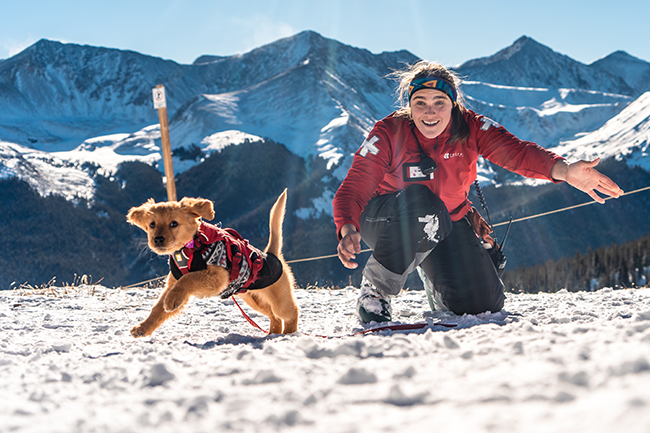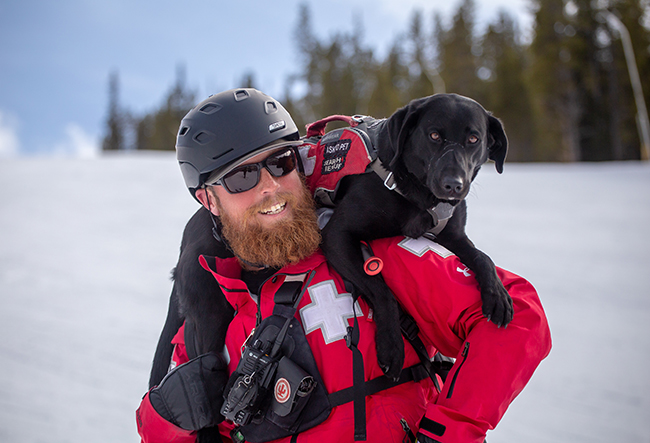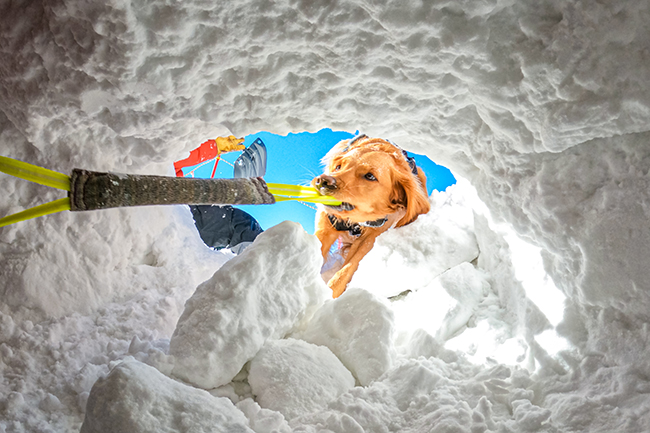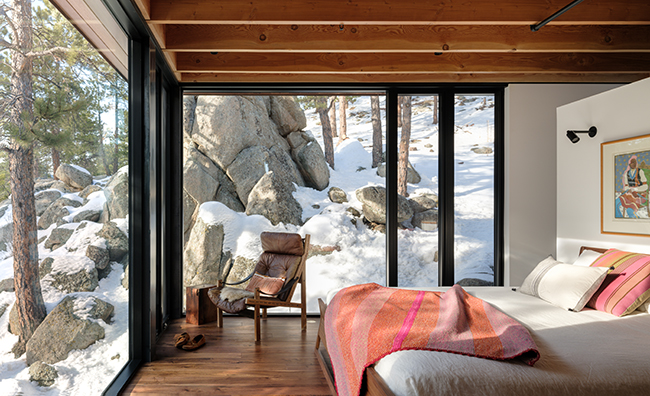Noses to the Ground
04 Feb 2024
Avalanche rescue dogs make the difference between life and death in the backcountry
By Brad Weismann

The winter wonderland of Colorado is legendary for its spectacular vistas and for the awesome adventures that its slopes provide. However, danger lurks there for the unwary. According to the Colorado Avalanche Information Center, an average of 27 people die in avalanches each winter in the United States.
Despite today’s advanced avalanche mitigation and safety techniques, the possibility of snowslides that could threaten lives still exists, especially beyond the groomed ski slopes, in out-of-bounds areas. Without using an avalanche beacon, skiers and other back-country types have no way to be found in an avalanche debris field.
That’s where avalanche rescue dogs and their human handlers come in.
“Basically, we’re a bunch of OCD people who want to rescue somebody,” jokes dog handler Zak Bloom, who, with his three-year-old golden retriever Maia, serves as part of the avalanche rescue team at the Keystone ski resort. Utilizing the dog’s acute sense of smell, and its enthusiasm for rescue work, these passionate volunteers are on the alert, ever-ready to save lives.

“The dog’s nose is at least 10,000 times more powerful than a human nose,” says Rico LaRocca, co-founder of the decade-old Winter Park Ski Patrol Avalanche Dog Program, who works with his six-year-old border collie, Biskit. “It can search an area in minutes that would take 30 trainers to cover on the terrain. So, they’re 30 times faster than humans.”
In Colorado, avalanche rescue dogs have been used since the mid-1980s. A large 1987 avalanche near Breckenridge that killed four skiers led to the inception of a program to train rescuers in-state to use dogs in avalanche situations. What is now known as Colorado Rapid Avalanche Deployment (C-RAD), a non-profit training and preparation entity, was born.
“When we started, there were 20 members of C-RAD. Now there’s a couple hundred,” says LaRocca.
All members of C-RAD must belong to a professional rescue organization, whether it be a ski patrol, a search and rescue team, county sheriff’s offices or the like. Members’ training begins even before they find dogs to train and work with.
“Prior to selecting a dog, experience handling other dogs or working with them is good,” says Rebecca “Bek” Karjian, who works with her dog Aley, a young golden retriever, at Copper Mountain. “I got the opportunity to help out a lot before I got Aley. I also attended dog school through the Colorado Rapid Avalanche Deployment program before I got her, to do skill building.”
Bloom concurs. “The Colorado Rapid Avalanche Deployment has standards that are very strict to uphold. C-RAD validation is a very strong recognition, through which people are verified to do the work. It takes many years of training. You start by auditing C-RAD classes. You watch and you talk with the trainers.”
The dog breeds most often chosen for rescue work include labradors, border collies, retrievers and German shepherds. “Labs and Goldens are thought to be some of the easiest to train,” says Karjian. “Shepherds and Collies are super smart and can do some awesome problem-solving. There are pros and cons to all the breeds, and it’s about handler preference and experiences in terms of choosing a dog.”
Dogs are chosen carefully for the program, usually selected from breeders or local ranchers. These are disciplined working dogs. Interviews, and meet-and-greets with prospective puppies, are held to determine a dog’s abilities.
“They have to be well-qualified; you want a dog lineage to be proven,” says Bloom. “You don’t want to get three years into training and find out that they have a bad heart or kidneys.”
Certain temperamental dispositions are important, too. A rescue dog must be intelligent, curious and fearless.
“’Drive is our biggest trait,” states C-RAD, “which is the dog’s energy and desire to complete the task it is being asked to do.”
Training for a rescue dog begins as early as eight weeks old. Part of the training is to accustom the dog to possible frights and distractions.
“We have them riding ATVs, boats; we have them deal with scuba divers,” says Bloom.
“We train them to climb ladders, do obstacle courses,” says LaRocca.
States Karjian of her dog, “I also looked for her not to be too ‘run into the fire’ type of dog. I threw scary things like shovels and skis in front of her. I wanted to make sure she wouldn’t run straight toward loud dangerous things, but also not be too scared.”

“We like to say we want a ‘bomb-proof’ dog,” says Bloom. “We use explosives, so a dog has to be tolerant of that.”
As the dogs’ skill sets grow and they bond with their handler, more complicated drills are held.
“Right now, we’re working on pop-up drills. I send someone out with her tug toy, and then I bring her out,” says Karjian. “Once we’re out, the person hiding pops up for just a second, makes some noise and then goes back to hiding. Then we ‘search.’ Sometimes we also do semi-blind drills. That’s where someone runs away with her toy while she sees them run away, but then she gets turned around so she can’t see where they went.”
Says Bloom, “We have a drill called the runaway. Basically, it’s people running away and hiding in the woods. We cover a lot of variables to make sure that the dogs are well taken care of.”
So, after all that training and validation, preparation and practice, what actually happens in the wake of an avalanche?
“The first step for avalanche rescue is usually visual identification from the air,” says Bloom. “They can see the avalanche and notice its direction, if there are any tracks leading to it. Then [the flights] will call the sheriff. The sheriff has a short list of contacts, so he gets on that, and we get the word.”
The avalanche rescue team consists of three components—the dog, the handler and an avalanche technician, whose duties are as vital as those of the first two. According to C-RAD, “This person is also able to operate as site commander and oversees all tasks and information relevant to the rescue.”
“Being an avalanche technician is the hardest job on the planet,” says LaRocca. “I’ve tried this job myself. A huge shout out because they have to spin into action. They handle ingress and egress and assess the safety of this particular situation, run an avalanche beacon, radio communications. Their hands are full; they usually have two radios and a telephone going at the same time.”
Time is of the essence. “When avalanches go,” says Karjian, “they ‘flow’ like a river. But then, once they stop, they harden up very quickly. Air can’t move to you when you’re buried under that concrete-like debris, which is why the timing of rescues are so important. Avalanche rescue is a discipline where every single second counts, and dogs can be one of the fastest ways to locate someone buried under snow.”
The team assembles and is transported as fast as possible to the site—sometimes, a helicopter is used. The ability of a person to survive buried in the snow is measured in mere minutes.
“We need to be ready to get called anytime we are at work,” says Karjian. “Dog handlers carry a go bag so we can have the fastest speed possible. The go bag contains rescue equipment and gear for Aley and I in the event we are out for a while.”
Says Bloom, “We load the helicopter with the handler, the dog, the avalanche tech, overnight gear, rescue gear and medical gear.”
Once on site, the team must quickly and efficiently interview the reporting party, then commence to search the avalanche field.
So, what motivates the rescue dogs? It’s a simple a thing as a “tug toy.” Once the dog has done its job, it gets to play tug with the handler, an activity that is enshrined in the dog’s mind as the ultimate reward.
“For a reward, we have a tug of war, no treats or anything distracting,” says LaRocca. “You get the greatest rewards when you think about how the dog thinks. There’s a wolf pack mentality, the sharing and tearing of meat. The whole key is the tug toy. Once the dogs learn the game, they want to party and celebrate their skills.”
Bloom concurs. “Her main reward is tugs. Our tug toys are not down on the floor, they are on the mantel, they are earned. Without that motivation, there’s going to be no drive. So, you have a toy hierarchy: She can always have a Kong or a chew toy. But then there are fetch toys and tug toys. These are strictly work-related and earned.”
Above all, it’s the bond between handler and dog that makes a successful avalanche rescue team. Says Karjian of her dog, “It’s incredible the balance she strikes between wanting to work and still wanting cuddles at the end of the day. Overall, the training process is long and can be challenging, but already the bond between me and Aley is one of the most special things I’ve ever been a part of.”












